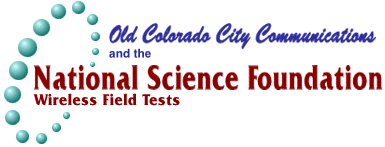
|
Voice 719.636.2040 · Fax 719.528.5869 ·Wireless Web http://wireless.oldcolo.com | ||
|
|
             |
Progress Report 18February 17th, 1998
The "Field Science by Wireless" NSF Project This is a short synopsis of this new project, as of Feb 16th, 1998. For the past 4 years, the 130 students 7th grade students in 6 classes of the Lewistown (pop 8,00) Montana Junior High School have been participating in a serious-science and community-important water testing and analysis project. They have been tramping down to Big Spring Creek during the school year and when the weather is tolerable (it can get to 40 below) as it comes into Lewistown, and collecting and analyzing a wide range of chemical, physical, flora and fauna characteristics of the stream which originates in the aquifer underneath the Snowy Mountains to the south of the remote and rural town in Central Montana. At one time the stream was a pristine, meandering creek, which measured, at its Spring source, the highest water quality (EPA standards) in the US. But industrial actions - the railroad early in the century, water control measures, - both re-channelized the stream in the 'Brewery Flats' and polluted it 7 miles downstream. Everyone, for decades has wanted to restore the stream. The 'Brewery Flats Restoration Project' is gathering support, and efforts are planned for the summer of 1998 to undertake a series of improvements. The effects of all of which have to be measured scientifically. The Lewistown students have, and will, play a key role in this monitoring. December 1997 to February 1998 our National Science Foundation (NSF) Wireless Field Tests for Education project worked out the details of how to support the project by granting to the Junior High and providing technological expertise to enable the students to do some of the advanced water monitoring (flow levels, opacity, conductivity, nitrates, pH, temperature, dissolved oxygen) remotely by a spread sprectrum wireless link between sensors constantly 'in the crick' and the computers in the classroom, which in turn are linked to the Internet, for access, study, transmission to national (NOAA) data bases, and in support the local community-wide project. Year round, and under the worst weather conditions. Real, and useful science, supurb undergraduate science education, and a leading edge exercise of solar and battery powered low cost, secure, high bandwidth, digital, no-licence wireless spread spectrum technology. On the 16th of Feb 1998, Dave Hughes, Principal Investigator of the NSF wireless projects laid out on tables at the public library, and turned over to Steve Paulson, teacher and the Lewistown School District all the component parts required for the project, (radios, antennas, connectors, solar panel, batteries, sensors, interfaces, and software), retained the services of local Inter-Tech (John Payne) and IMAC (Forrest Christian) who will fabricate the field enclosure with the help of the Furgus High School shop personnel, and technically interface everything. The team that met in Lewistown on the 16th, bench and field tested the wireless links. Hughes instructed the team on project benchmarks and reporting requirements over the next year. The school also committed to being part of a national demonstration of this project and wireless technology on May 5th, 1998, at the Emerging Wireless Technologies Conference, where Vice President Gore is expected to make the keynote address. He will video-conference with the Science Class in Lewistown, and then, on the student's instructions, via satellite and terrestrial Internet link to the classroom, and by spread spectrum wireless to 'the Crick,' fetch real-time water data readings via a laptop at the podium, for display before the conferees in the auditorium at George Washington University in Washington. The complete system is expected to be fully operational at Big Spring Creek to the classroom computers for education use within 30 days. Information on this project, and all updates, possibly including the ability of all web browser users in the world to fetch data from the Crick at any time, will be on http://wireless.oldcolo.com - the NSF Wireless Field Tests for Education web site over the next year.
Dave Hughes 

|

